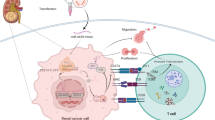Abstract
MicroRNAs (miRNAs) are a class of small noncoding RNAs, which regulate gene expression in the posttranscriptional level. They are involved in cancer occurrence and development. Different members of the same miRNA family may have different roles. Since the fact that metastasis is the main cause of cancer-related death and miR-129 has three members, in this study, we focused on the migration inhibitory role of miR-129-1-3p in gastric cancer and explored the possible mechanisms. We first compared the expression of three miR-129 family members, miR-129-5p, miR-129-1-3p, and miR-129-2-3p, between gastric carcinoma tissues and surgical margin non-cancer samples by quantitative real-time reverse transcription-polymerase chain reaction (QRT-PCR). Then, we selected miR-129-1-3p for further analysis and transfected its mimic and inhibitor into gastric cancer BGC-823 cells, respectively. Then, we compared the BGC-823 cells’ migration capacity by transwell assay. Finally, we predicted the possible targets of miR-129-1-3p and selected one target for further analysis by QRT-PCR and luciferase reporter assay. The results showed that the expression of miR-129-1-3p in gastric carcinoma was significantly lower than that in surgical margin samples. And miR-129-1-3p could inhibit the migration of BGC-823 cells. From the candidates, we selected bradykinin receptor B2 (BDKRB2), which was reported relating to metastasis, as a target for further analysis. QRT-PCR showed that the expression of BDKRB2 was negatively related to miR-129-1-3p. Luciferase reporter assay showed that BDKRB2 was the target of the miR-129-1-3p. In summary, miR-129-1-3p inhibits the BGC-823 cell migration by targeting BDKRB2.





Similar content being viewed by others
References
Comen EA. Tracking the seed and tending the soil: evolving concepts in metastatic breast cancer. Discov Med. 2012;14:97–104.
Shi X, Sun M, Liu H, et al. Long non-coding RNAs: a new frontier in the study of human diseases. Cancer Lett. 2013;339:159–66.
Qi W, Liang W, Jiang H, et al. The function of miRNA in hepatic cancer stem cell. Biomed Res Int. 2013;2013:358902.
Izzotti A, Cartiglia C, Steele VE, et al. MicroRNAs as targets for dietary and pharmacological inhibitors of mutagenesis and carcinogenesis. Mutat Res. 2012;751:287–303.
Brest P, Lassalle S, Hofman V, et al. MiR-129-5p is required for histone deacetylase inhibitor-induced cell death in thyroid cancer cells. Endocr Relat Cancer. 2011;18:711–9.
Wang QY, Tang J, Zhou CX, et al. The down-regulation of miR-129 in breast cancer and its effect on breast cancer migration and motility. Sheng Li Xue Bao. 2012;64:403–11.
Liu Y, Hei Y, Shu Q, et al. VCP/p97, down-regulated by microRNA-129-5p, could regulate the progression of hepatocellular carcinoma. PLoS ONE. 2012;7:e35800.
Yu X, Luo L, Wu Y, et al. Gastric juice miR-129 as a potential biomarker for screening gastric cancer. Med Oncol. 2013;30:365.
Karaayvaz M, Zhai H, Ju J. miR-129 promotes apoptosis and enhances chemosensitivity to 5-fluorouracil in colorectal cancer. Cell Death Dis. 2013;4:e659.
Li M, Tian L, Wang L, et al. Down-regulation of miR-129-5p inhibits growth and induces apoptosis in laryngeal squamous cell carcinoma by targeting APC. PLoS ONE. 2013;8:e77829.
Zhang J, Li S, Yan Q, et al. Interferon-β induced microRNA-129-5p down-regulates HPV-18 E6 and E7 viral gene expression by targeting SP1 in cervical cancer cells. PLoS ONE. 2013;8:e81366.
Wu J, Qian J, Li C, et al. miR-129 regulates cell proliferation by downregulating Cdk6 expression. Cell Cycle. 2010;9:1809–18.
Shen R, Pan S, Qi S, et al. Epigenetic repression of microRNA-129-2 leads to overexpression of SOX4 in gastric cancer. Biochem Biophys Res Commun. 2010;394:1047–52.
Huang HY, Cheng YY, Liao WC, et al. SOX4 transcriptionally regulates multiple SEMA3/plexin family members and promotes tumor growth in pancreatic cancer. PLoS ONE. 2012;7:e48637.
Chen X, Zhang L, Zhang T, et al. Methylation-mediated repression of microRNA 129-2 enhances oncogenic SOX4 expression in HCC. Liver Int. 2013;33:476–86.
Yu HS, Lin TH, Tang CH. Involvement of intercellular adhesion molecule-1 up-regulation in bradykinin promotes cell motility in human prostate cancers. Int J Mol Sci. 2013;14:13329–45.
Yu HS, Lin TH, Tang CH. Bradykinin enhances cell migration in human prostate cancer cells through B2 receptor/PKCδ/c-Src dependent signaling pathway. Prostate. 2013;73:89–100.
Montana V, Sontheimer H. Bradykinin promotes the chemotactic invasion of primary brain tumors. J Neurosci. 2011;11:4858–67.
Yu X, Song H, Xia T, et al. Growth inhibitory effects of three miR-129 family members on gastric cancer. Gene. 2013;532:87–93.
Vassou D, Notas G, Hatzoglou A, et al. Opioids increase bladder cancer cell migration via bradykinin B2 receptors. Int J Oncol. 2011;39:697–707.
Erices R, Corthorn J, Lisboa F, et al. Bradykinin promotes migration and invasion of human immortalized trophoblasts. Reprod Biol Endocrinol. 2011;9:97.
Jiang J, Liu W, Guo X, et al. IRX1 influences peritoneal spreading and metastasis via inhibiting BDKRB2-dependent neovascularization on gastric cancer. Oncogene. 2011;30:4498–508.
Acknowledgements
This work was supported by the Applied Research Project on Nonprofit Technology of Zhejiang Province (No. 2012C23127), Scientific Innovation Team Project of Ningbo (No. 2011B82014), and The K. C. Wong Magna Fund in Ningbo University.
Conflict of interest
The authors declare that they have no conflict of interest.
Author information
Authors and Affiliations
Corresponding authors
Rights and permissions
About this article
Cite this article
Wang, D., Luo, L. & Guo, J. miR-129-1-3p inhibits cell migration by targeting BDKRB2 in gastric cancer. Med Oncol 31, 98 (2014). https://doi.org/10.1007/s12032-014-0098-1
Received:
Accepted:
Published:
DOI: https://doi.org/10.1007/s12032-014-0098-1




